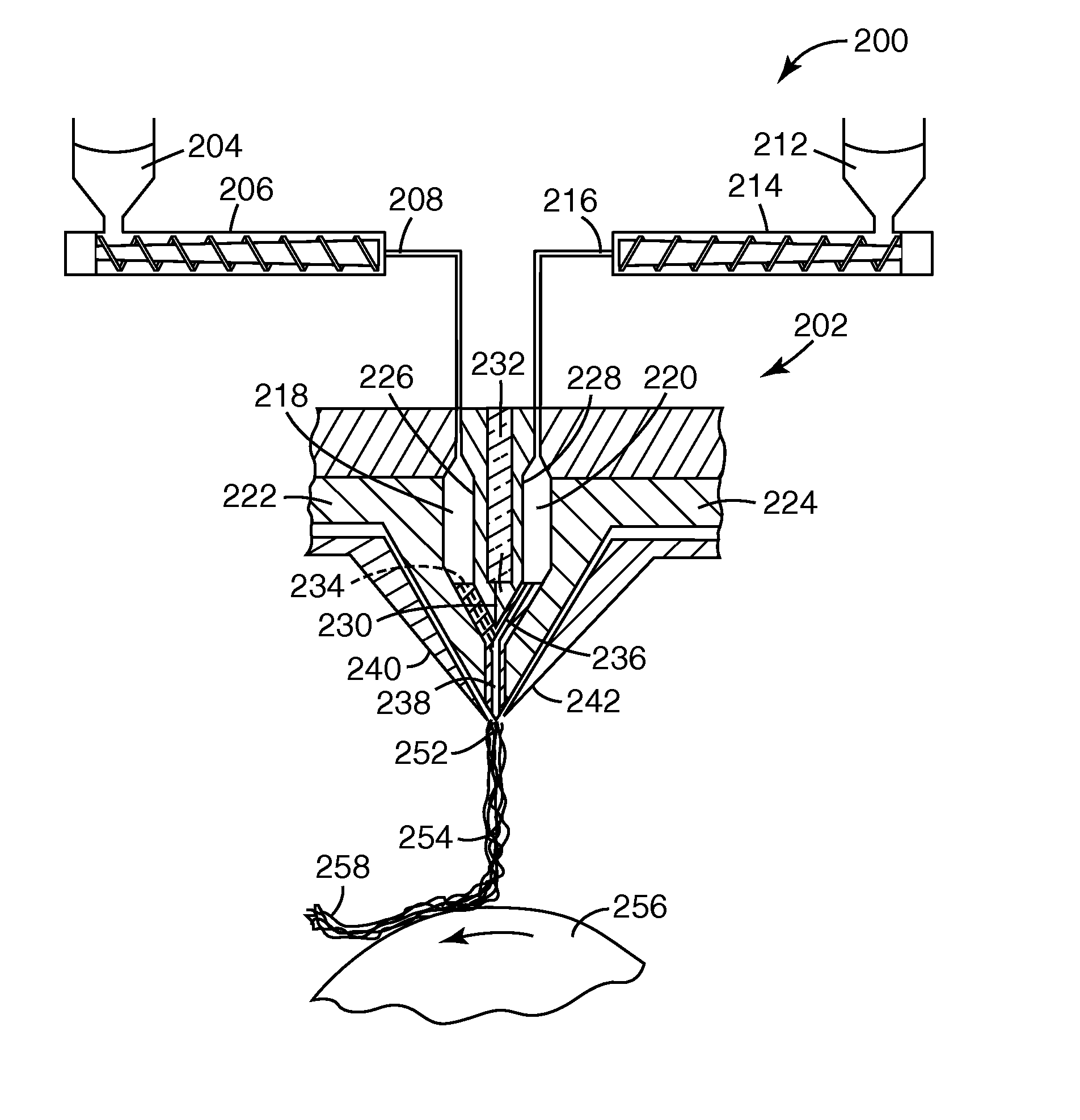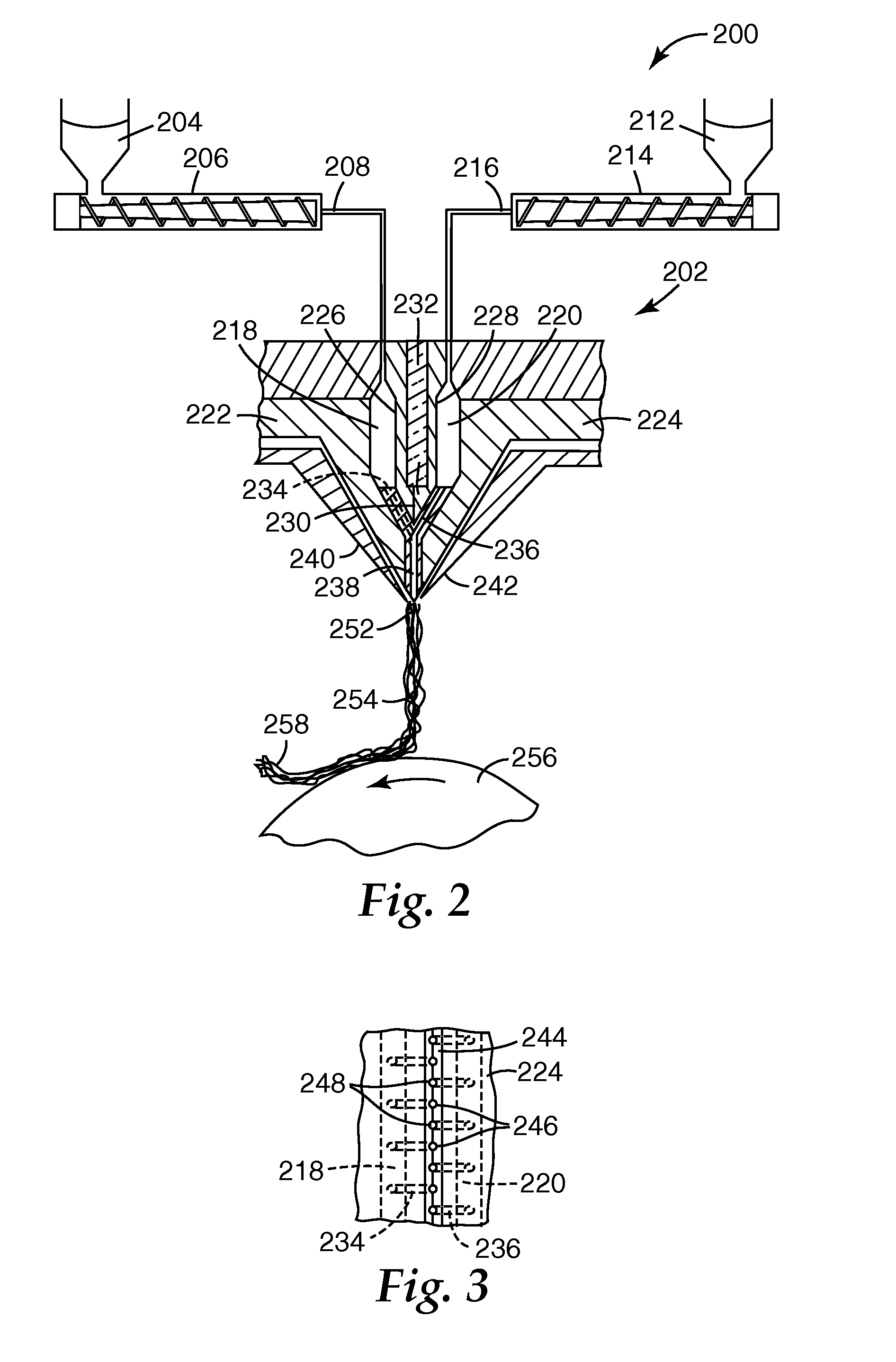Method for making shaped filtration articles
a filtration article and shaped technology, applied in the field of nonwoven webs, can solve the problem of limiting the extent to which charges may be applied, and achieve the effects of improving stiffness, improving moldability, and increasing fiber surface area
- Summary
- Abstract
- Description
- Claims
- Application Information
AI Technical Summary
Benefits of technology
Problems solved by technology
Method used
Image
Examples
example 1
[0068]Using an apparatus like that shown in FIG. 2 and FIG. 3 and procedures like those described in Wente, Van A. “superfine Thermoplastic Fiber”, Industrial and Engineering Chemistry, vol. 48. No. 8, 1956, pp 1342-1346 and Naval Research Laboratory Report 111437, Apr. 15, 1954, a meltblown monocomponent monolayer web was formed from larger fibers and smaller size fibers of the same polymeric composition. The larger size fibers were formed using TOTAL 3960 polypropylene (a 350 melt flow rate polymer) to which had been added 0.8% CHIMASSORB 944 hindered amine light stabilizer as an electret charging additive and 1% POLYONE™ No. CC10054018WE blue pigment from PolyOne Corp. to aid in assessing the distribution of larger size fibers in the web. The resulting blue polymer blend was fed to a Model 20 DAVIS STANDARD™ 2 in. (50.8 mm) single screw extruder from the Davis Standard Division of Crompton & Knowles Corp. The extruder had a 60 in. (152 cm) length and a 30 / 1 length / diameter ratio....
example 2
[0073]Example 1 was repeated without using the electret charging additive in either the larger size or smaller size fibers. The web was plasma charged according to the technique taught in U.S. Pat. No. 6,660,210 (Jones et al.) and then hydrocharged with distilled water according to the technique taught in U.S. Pat. No. 5,496,507 (Angadjivand et al. '507) and allowed to dry. Set out below in Table 2A are the Run Number, basis weight, EFD, web thickness, initial pressure drop, initial NaCl penetration and Quality Factor QF for the flat web at a 13.8 cm / sec face velocity:
[0074]
TABLE 2AQualityBasisPressureFactor,RunWt.,EFD,Thickness,Drop, mmInitial1 / mmNo.gsmμmmmH2OPenetration, %H2O2-1F20413.44.925.21.90.76
[0075]The Table 2A web was next molded according to the method of Example 1. Upon removal from the mold, the matrix retained its molded shape. Set out below in Table 2B are the Run Number, King Stiffness, initial pressure drop, initial NaCl penetration and maximum loading penetration f...
example 3
[0078]Using the method of Example 1, a monocomponent monolayer web was formed. The larger size fibers were formed using TOTAL 3868 polypropylene (a 37 melt flow rate polymer) to which had been added 0.8% CHIMASSORB 944 hindered amine light stabilizer from Ciba Specialty Chemicals as an electret charging additive and 2% POLYONE™ No. CC10054018WE blue pigment. The smaller size fibers were formed using EXXON PP3746G polypropylene to which had been added 0.8% CHIMASSORB 944 hindered amine light stabilizer. The polymer output rate from the extruders was 1.5 lbs / in / hr (0.27 kg / cm / hr), the DCD (die-to-collector distance) was 13.5 in. (34.3 cm) and the polymer rate from each extruder was adjusted to provide a web with 65% larger size fibers and 35% smaller size fibers. The web was hydrocharged with distilled water according to the technique taught in U.S. Pat. No. 5,496,507 (Angadjivand et al. '507) and allowed to dry. Set out below in Table 3A are the Run Number, basis weight, EFD, web thi...
PUM
| Property | Measurement | Unit |
|---|---|---|
| size | aaaaa | aaaaa |
| size | aaaaa | aaaaa |
| size | aaaaa | aaaaa |
Abstract
Description
Claims
Application Information
 Login to View More
Login to View More - R&D
- Intellectual Property
- Life Sciences
- Materials
- Tech Scout
- Unparalleled Data Quality
- Higher Quality Content
- 60% Fewer Hallucinations
Browse by: Latest US Patents, China's latest patents, Technical Efficacy Thesaurus, Application Domain, Technology Topic, Popular Technical Reports.
© 2025 PatSnap. All rights reserved.Legal|Privacy policy|Modern Slavery Act Transparency Statement|Sitemap|About US| Contact US: help@patsnap.com



